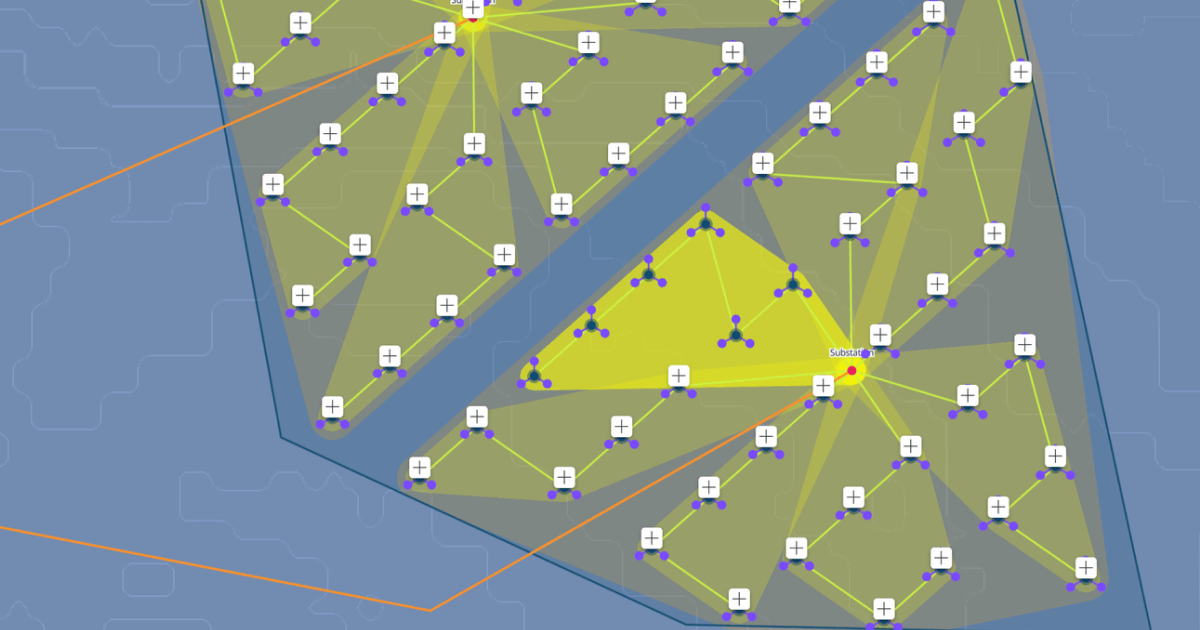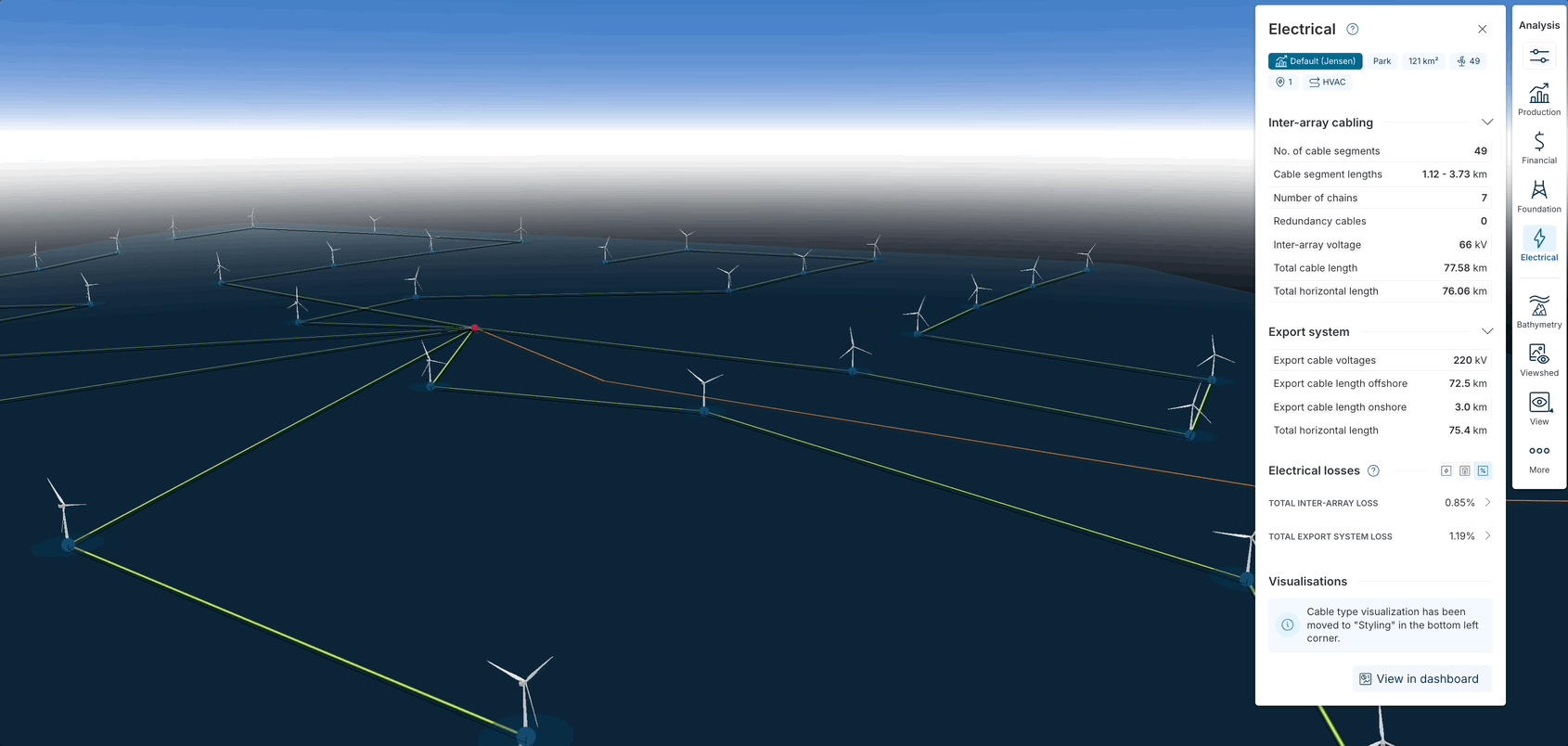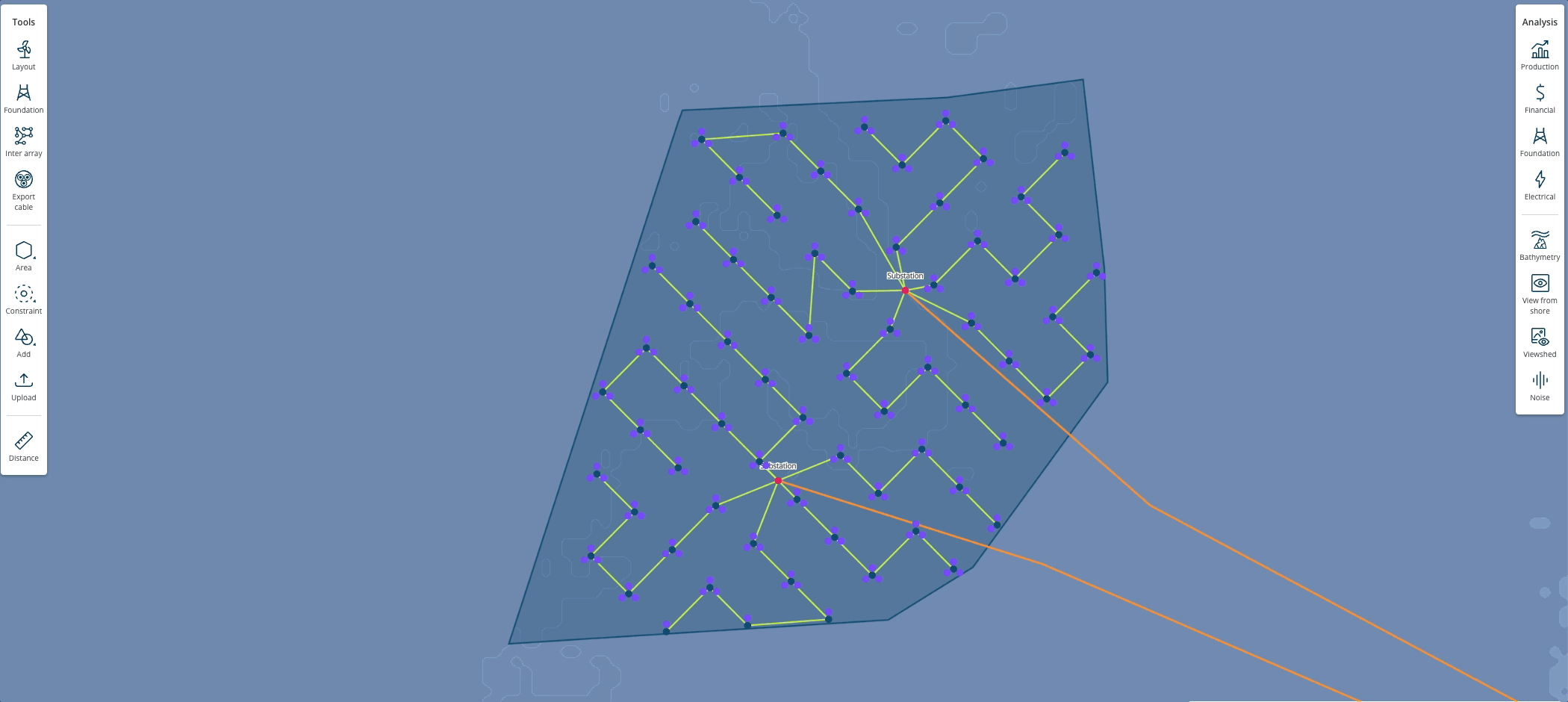Quickly model, analyse and optimise the electrical system for your site. The Vind AI platform takes a whole systems approach to optimisation, allowing co-optimisation of layout and electrical design. Perform initial design in minutes based on component templates and efficient optimisation algorithms—or tailor everything based on your project-specific input and requirements.

Generate initial inter array layout designs in seconds with our built-in optimisation tool to minimise total cable length, automatically considering exclusion zones, turbines, road networks and other park structures. For offshore wind parks, you can optimise substation placement in-the-loop to minimise cable lengths and save costs.
In Vind AI, the electrical system optimisation is integrated with the wind turbine layout optimisation. Any updates to turbine positioning—or other project assumptions like wind resources—and the platform automatically recalculates cable lengths, electrical losses, and total energy yield. The integrated optimisation is designed to keep the entire system coherent and up to date.

Perform electrical loss calculations for both inter array and export systems based on state-of-the-art power flow analyses and hourly-based park production time series. Analyses are automatically updated to reflect your latest park design and wind data, enhancing collaboration and avoiding the issue of outdated results. Easily compare different electrical designs in terms of losses, net production, or even LCoE.

Model both inter-array cable losses and export cable losses, including turbine transformer losses, cable losses (with optional dielectric losses) and onshore and offshore substation transformer losses.
Build and analyse complete export system models. Use thousands of built-in data layers and high-quality bathymetry, terrain and road data to plan optimal cable routes and connect to existing infrastructure. For offshore projects, consider both HVAC and HVDC options, with options for reactive power compensation if needed, ensuring accurate production estimates all the way to the grid connection.

Use component templates to quickly establish first estimates, or tailor model inputs to reflect project-specific requirements. Create your own cable types, transformers and converters, which seamlessly can be used across different projects. Generate custom reports with powerful visualisations for easy interpretation of results, or deep-dive into the details based on a comprehensive set of statistics.
While Vind AI can give you an initial design for electrical systems for your wind park, we know that expert designers have expertise and knowledge that cannot be outsourced to algorithms. Within the platform, you are always free to make manual adjustments to the automated optimisation results, or draw completely new ones yourself. (And you can also easily upload designs made outside of the platform to develop them further within Vind AI).
Speed up your workflows by automating initial optimisations of the electrical system for your wind farm, before perfecting the design manually within the platform using your team’s unique human expertise and knowledge.
Optimising your wind turbine layout and electrical cable design in a single digital platform in an integrated way enables a fast, responsive feedback loop between the yield engineers and the electrical engineers, resulting in smarter decisions being reached faster.
Electrical system design in Vind AI is web-based and collaborative, which means multiple team members—whether electrical engineers or from other disciplines—can work together simultaneously. Changes are reflected instantly across the project, so your electrical system design will always be based on the latest from the rest of the project team, and vice versa.
Speed up your workflows by automating initial optimisations of the electrical system for your wind farm, before perfecting the design manually within the platform using your team’s unique human expertise and knowledge.
Optimising your wind turbine layout and electrical cable design in a single digital platform in an integrated way enables a fast, responsive feedback loop between the yield engineers and the electrical engineers, resulting in smarter decisions being reached faster.
Electrical system design in Vind AI is web-based and collaborative, which means multiple team members—whether electrical engineers or from other disciplines—can work together simultaneously. Changes are reflected instantly across the project, so your electrical system design will always be based on the latest from the rest of the project team, and vice versa.
Fast iterations and an easy comparison set-up means you can test many more scenarios for electrical systems design much faster than what you do today, so you can be sure you have identified the best solutions for your project in a fast-changing environment.
Speed up your workflows by automating initial optimisations of the electrical system for your wind farm, before perfecting the design manually within the platform using your team’s unique human expertise and knowledge.
Optimising your wind turbine layout and electrical cable design in a single digital platform in an integrated way enables a fast, responsive feedback loop between the yield engineers and the electrical engineers, resulting in smarter decisions being reached faster.
Electrical system design in Vind AI is web-based and collaborative, which means multiple team members—whether electrical engineers or from other disciplines—can work together simultaneously. Changes are reflected instantly across the project, so your electrical system design will always be based on the latest from the rest of the project team, and vice versa.
Fast iterations and an easy comparison set-up means you can test many more scenarios for electrical systems design much faster than what you do today, so you can be sure you have identified the best solutions for your project in a fast-changing environment.
Speed up your workflows by automating initial optimisations of the electrical system for your wind farm, before perfecting the design manually within the platform using your team’s unique human expertise and knowledge.
Optimising your wind turbine layout and electrical cable design in a single digital platform in an integrated way enables a fast, responsive feedback loop between the yield engineers and the electrical engineers, resulting in smarter decisions being reached faster.
Electrical system design in Vind AI is web-based and collaborative, which means multiple team members—whether electrical engineers or from other disciplines—can work together simultaneously. Changes are reflected instantly across the project, so your electrical system design will always be based on the latest from the rest of the project team, and vice versa.
Fast iterations and an easy comparison set-up means you can test many more scenarios for electrical systems design much faster than what you do today, so you can be sure you have identified the best solutions for your project in a fast-changing environment.